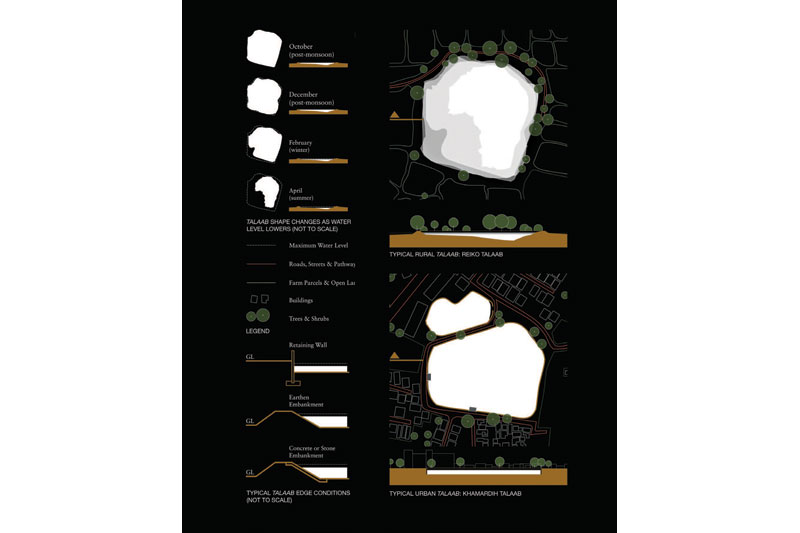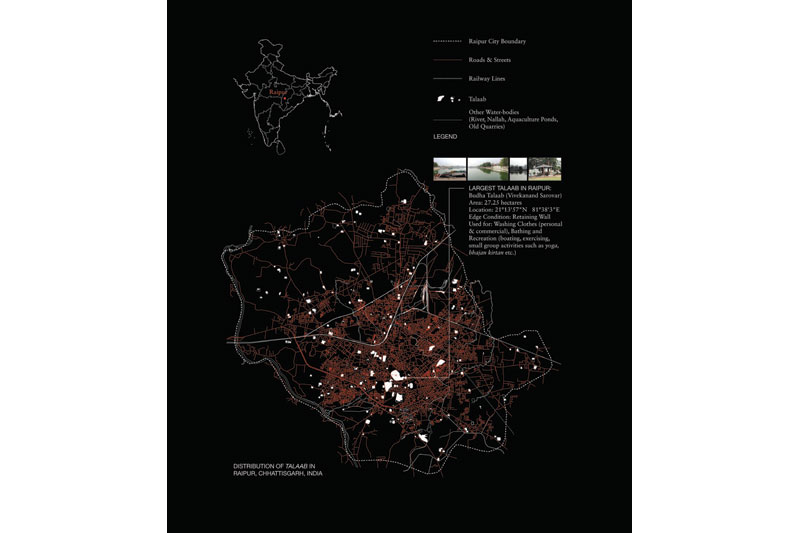Environment & Ecology
Troubled Waters: Talaab System in Raipur | Alpa Nawre
LA 43 |
|
| With a land completely dependent on the annual monsoon and often plagued by acute water shortage, the people of India have developed water harvesting strategies over the years. One such innovation is the talaab- a human made water body created in depressions in the natural ground. It has, over time, been closely integrated in the social and cultural life of the vernacular community. Unfortunately, however, the importance of this multi-faceted water harvesting system is often overlooked and not considered relevant to the contemporary setting of today. It is important that the role these water bodies play in the urban fabric be acknowledged and that they be integrated into designs as a way to manage water effectively. |
|
 |
|
A talaab is a human-made water body created in natural depressions in the landscape or on level ground with dams, embankments or short retaining walls to gather the monsoonal rainwater for use later in the year. Most talaab retain water throughout the year but some are ephemeral and hold water for only a few months starting from the monsoon season up until the winter. In the Indian landscape, where every space is put to multiple uses, the talaab system is no different. They are identified as places of respite and recreation, of religious and cultural significance through various sacred rites associated with water, put to utilitarian use such as irrigation and washing and act as sources of employment through aquatic food and flower production. Talaab provide aquatic habitat, flood prevention, thermal regulation and aesthetic pleasure. They act as swimming pools for humans and wallowing ponds for water buffaloes during the hot Indian summers. Vendors line at the edges of some talaab offering snacks for sale and entertainment activities like boating. Over centuries, these natural low-points of the landscape have thus been translated over the parameters of culture to become key centers of adjacent neighborhoods, through a richly layered utilitarian, ecological, social and religious performance, in addition to the primary function of storing water (Nawre 2013).
Once a robust system, the talaab system has deteriorated badly in contemporary India. Even in its degraded state, it fulfils a majority of the non-potable water needs for both the urban and rural poor of India. There are many studies on water management in the developing countries of China and Latin America (Wehrhahn, et al. 2008), with very few in South Asia (Baier 2011). India faces acute water management issues. The imminent exhaustion of ground water is a threat to agriculture and human survival itself in the sub-continent. This is going to lead to a demand for greater reliance on surface water supply systems (Briscoe and Malik 2006). Hence, there is an urgent need to study existing vernacular systems of surface water management such as the talaab to ensure that water infrastructure development funding in India is channelled into establishing sustainable solutions that work with local assets, challenges and characteristics of land and water. In this context, understanding the state of these water bodies to develop solutions aimed at their conservation and incorporation in sustainable water management strategies is important because a rejuvenated talaab system can address the increasing incidences of urban flooding and water scarcity in the country, especially benefiting the economically weaker sections of society and supplying irrigation water.
|
|


|
|

|
|
|
|
|